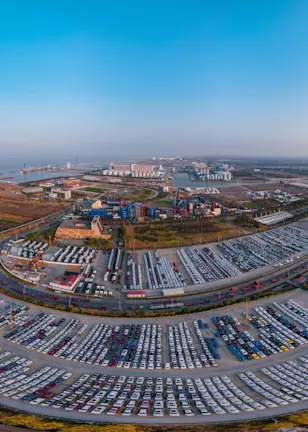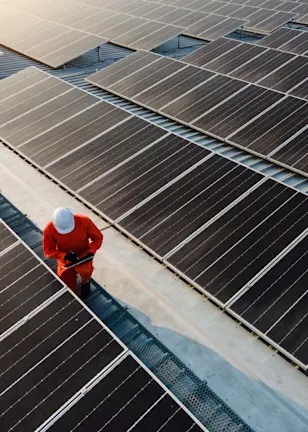Transcript
We do not guarantee the accuracy of this transcript.
This podcast is for professional investors only.
Erika van der Merwe (EM): Perhaps one of the biggest surprises of the past year has been the resilience of the major economies. Households and businesses in the US and Europe have held up remarkably well in spite of sky-high policy rates. Could this mean that we’ve managed to somehow avoid a full-blown recession? Robeco’s multi -assets team warns against thinking that this time might be different.
Welcome to a new episode of the Robeco podcast.
EM: My guests to discuss this are Colin Graham and Peter van der Welle. Colin is head of Robeco’s Multi-Asset Strategies and Peter is a strategist in the Sustainable Multi-Asset Solutions team. Welcome, gentlemen. Good to have you here.
Both: Hi Erika.
EM: So, Peter, you and the team with Colin and co., you’ve just published your one-year outlook. It’s an annual event, of course, so the essence of your message this time around is that there’s no guarantee of a soft landing. Are markets then being too optimistic because it seems to be the consensus view that we might have a soft landing?
Peter van der Welle (PvdW): At first sight, there’s a lot of positive things going on in the global economy and we have seen a swift disinflation from exceptionally high levels without the steep increase in unemployment. And that’s quite a rare circumstance because we have never seen such a smooth disinflation in recent history. Most often you are already seeing recessions whenever you have seen a very aggressive rate hike cycle like we have been observing this year.
EM: You say most often, always?
PvdW: Well, actually, recessions are the rule rather than the exception when central bank hikes policy rates by more than 400 basis points.
EM: So what’s going on, Colin?
Colin Graham (CG): Peter’s right, so overall the economy’s done very well, but if you actually look at the manufacturing sector, that’s actually been a recession pretty much all of this year. So parts of the economy have not done very well this year. It’s the services side which has really kept up. We think that’s been due to the fact that there’s been massive pro-cyclical fiscal stimulus around the world from Europe, from the US, and that has put money in consumers’ pockets. And they’ve been willing to pay whatever price it is to go on holiday, to go and eat out, paying for experiences. So we think that’s really what’s elongated the cycle rather than actually avoided recession at all.
EM: So Peter, in the publication, you used this lovely term ‘fooled by randomness’. So what do you mean by that?
PvdW: Well, if you look at the typical lags between tightening of the policy and the economic downturns, then these lags are highly variable. And back in 2022, we thought – based on the historical average lag between tightening of monetary policy and the subsequent economic downturn – that we would already face a US recession by the end of 2023. Clearly, and this time around, we have been fooled by variable lags and such, fooled by randomness.
EM: Another great phrase that you use, but as you point out, it’s not your own, is that it’s the end of immaculate disinflation, explain.
PvdW: Yeah, so that’s a term that appeared in the paper by Blanchard and Bernanke. And they pointed out that this time it looks different because of that smooth disinflation process triggered by the onset of monetary tightening back in early 2022. And normally, there’s a higher, so-called ‘sacrifice ratio’ between on the one hand containing inflation and on the other hand trying to mitigate an economic downturn as a central banker. So [it’s] normally a very steep trade-off, but not this time around. So for consensus, it seems like central banks are achieving their goal of bringing inflation back to targets, back to the two percent without tanking the economy. And that very process looks like a spotless disinflationary process.
EM: But it’s not. So Colin, as Peter said, a year ago, you were forecasting that by now we could be in the last lag of a bear market, things would get tougher, but it hasn’t ended up that way. So what happened? And what have things looked like this year? Have you experienced it?
CG: Well, if we look at the equity markets for a start, we can see that the equity market returns have been driven by seven magnificent stocks [the Magnificent Seven]. But if you actually look at the rest of it, it hasn’t done very well. So there has been this bifurcation and those seven stocks have really hidden some of the tightening that have really come through into equities. Funding rates going up, having to go back to the market. We know that people have termed out their debt. So people have got mortgage, especially in the US, fixed rate, 30 years at 1.5%. Doesn’t matter what today’s interest rate is, as long as they don’t have to move. And they don’t have to move because the unemployment rate has stayed very, very low.
EM: Right.
CG: So it’s the unemployment part of the equation that hasn’t really happened yet. And once that starts, then you’ll start to see more movement within the consumer when people worry about their jobs, worry that they won’t be able to afford. And we’re beginning to see credit cards, delinquencies, credit card spending go up. And we saw that in particularly over Black Friday and Cyber Monday.
EM: So in this context then, which assets have been resilient and which haven’t?
CG: Good question. So well, if you actually look now, we’re probably going to end the year with positive returns from Global Bonds, which we haven’t for the last two years. So you can say they’ve been resilient because in November, we saw 60 basis point fall in the US 10 year, which last time that happened was can you guess it?
EM: No, Peter?
CG: 2008 –so in the depths of the GFC. So, that’s not something you would expect to see in a bull market for equities. So there are other signals that are out there, the inversion of the yield curve, which just haven’t come to fruition yet.
EM: US dollars remain strong because of the interest rate differential, right?
CG: Yeah, and that’s put pressure on emerging markets. So not only the struggle with China and the restimulation of their economy after COVID-exit, they’re trying to put measures in place, but the strong [US] dollar is really hurting emerging markets. Some have done well. And Peter, you’ve talked about Latin America all year: about the opportunities there and how real rates can come down in those countries. So again, when you scrape the surface, there are opportunities there, looking for those diamonds in the rough.
PvdW: Yeah, some EM central banks have preempted the tightening cycle in developed economies. And therefore they also have contained inflation relative to their inflation targets a bit earlier compared to the DM counterparts. And therefore also you have seen growth improving earlier compared to DM.
EM: So let’s take a look now. So we’ve looked at this past year, how things have played out. But let’s take a look then at why you’re not banking on a soft landing for 2024. In other words, things could get tighter after all. So what are you reading from the macroeconomic fundamentals, Peter, and how this will shape 2024?
PvdW: Yeah, so the US consumer is a very important element in the whole equation for 2024. If the US consumer were to throw in the towel, then [the] US economy would stagnate, and that would also have repercussions for the broader global economy. US consumption is 70% of total added value in the US. And if you look at what has held up US consumption, it has been excess savings after the huge monetary and fiscal stimulus. They have built up huge savings, but they have been, at this point in time, largely spent. And also you do see that the willingness to spend is declining. So savings ratios are going up again. And if you look at the labor market, then there are already some cracks appearing, so if you look at leading indicators for US unemployment, and we look at a bunch of them, four to five leading indicators, and they all point to a potential uptick in US unemployment by 1-2%, and that’s really not what the consensus [is] – and by the way also not [what] the Fed is penciling in for the end of 2024. So the Fed, if you look at the median dot plot, they expect a 4.1% US unemployment rate by the end of 2024. Not a 5-5.5% US unemployment rate.
And if you look at what that could mean for US consumption growth, 1-2 % uptick in unemployment, it would shave off also 1-2 % US consumption growth. So if that were to materialize, that the cracks in the US labor market widen, then it could very well be that you will see a stagnant US economy in 2024, generating subpar growth of around 1%.
EM: So some real risks there, but as you also pointed out, it’s not only about the macroeconomics. You’ve highlighted other factors at play too. For one, you’re expecting some liquidity conditions to tighten.
PvdW: Yeah, so if you look at reserve bank balances at the Fed as percentage of US GDP, currently they are at 11.8% and if they are declining below 10%, that could trigger lower liquidity in the overall markets because that’s also what we have seen in the last QT episode. So back then also the bank reserves as percentage of GDP [even] dropped to 7%. And then the Fed also had to hold the QT trajectory.
EM: So for investors, the consequences of tighter liquidity conditions, what would happen?
CG: Well, you’d see the opposite of QE. So after the last 15 years of very loose monetary policy, you’ll start to see that tighten. And then what you see is all those projects (that shouldn’t have got off the ground because their return on capitals was low) start to struggle. So the best case, we’ve never been in this situation before, but if you think what QE did and then just turn the sign around from positive to a negative, then that’s what we’re thinking in terms of the effect of QT. But every time there’s been a wobble, central banks have stopped QT and actually expanded their balance sheets again. So you just have to watch that.
EM: Right. Helicopter money, helicopter parenting by the central banks. And geopolitics are a further fact. And of course, it’s so difficult to forecast, you know, from which angle it’s going to be coming. And of course, everyone has their ideas. So you made the point, Peter, and if it’s your writing, and they’re saying that investors are not necessarily pricing in all the risks that’s currently evident in the market relating to geopolitics.
PvdW: Yeah, so if you look at metrics for geopolitical policy uncertainty, and there’s one important indicator that’s clearly trending up for years now. And if you relate that to, for instance, equity risk premia, then clearly the equity risk premia is not fully reflective of the underlying geopolitical risks. And eventually geopolitical risks could also spill over into higher cash flow volatility because geopolitical risk, for instance, could imply higher frequency of negative supply side shocks, some rebels taking over a ship in the Red Sea for instance, a blockage in the Suez canal, that can all trigger negative supply shocks and therefore have repercussions in the end for investors because [of] higher cash flow volatility or even outright negative cash flows.
EM: To make the point, so these are some of the factors that you've highlighted in your one-year outlook on why you think we can expect more than a soft landing. It could be indeed harder than what the market’s pricing in.
CG: Unfortunately, in the past, most recessions look like soft landings to start with, and then they turn into recessions. So for us, where we’ve been successful in our portfolios this year is really waiting for sentiment to get to extremes and then taking the opposite side. So at the moment, soft landing is the consensus. That’s where everybody is, and everybody’s positioned their portfolios, as we can see from the performance in November. However, so for us, it’s like thinking about, well, okay, which assets are being mispriced? And we think there’s a few out there that are mispriced for – well, the price for a soft landing and the immaculate disinflation, and therefore it’s worth taking a view against those.
EM: Well, I’ll be picking up on that point in a few minutes time, but first it’s time for our quiz. So here we go guys, are you ready?
Aside from the sustained resilience that we’ve seen in US and European economies, what’s the single biggest surprise? What’s been the single biggest surprise for you in 2023? Colin.
CG: So for me, it was the fact that Taylor Swift had such an amazing concert tour in the US – they reckon it’s [USD] 4.6 billion added to the economy in spending. J. Powell was asked at one of the FOMC meetings about the Swift effect. And you’ve actually seen Harvard is going to launch a course next year dedicated to studying her and her effect.
EM: Well, Peter, you’re a classical musician. I’m not sure if this falls within your ambit.
PvdW: Well, I like Taylor Swift and I do have a pretty boring answer compared to Collins on this quiz and that is for me the biggest surprise has been that there hasn’t been a US recession because the conditional probability of a US recession playing out in 2023 was astonishingly high. So if you look at the paper put out by Summers back in April 2022, they calculated that if you look back in history, every time when US unemployment was below 5% and inflation above 5%, then you had always seen a US recession playing out in the next 12 to 24 months. Also, the yield curve, as Colin highlighted, had been inverted. Also, quite a reliable US recession indicator. We have had that manufacturing recession starting by the end of last year. So yeah, a lot of reliable indicators seem to be aligned for that US recession.
EM: On to the second question. Got a clip to play for you.
[Unidentified older man’s voice]: Of course, we wised up over time. We got into better and better accommodation. And we understood more and more of the bad things that could happen to you and how easy they could creep in.
EM: So who is that and what have you learned from him over the years?
Both: Charlie, it’s Charlie.
EM: Indeed, it’s Charlie Munger, Warren Buffett’s long-time investment partner. What have you learned from him over the years?
CG: Well one of the questions stands out for me and one of the ways that Warren Buffett changed his views was, Charlie, why don’t you look for really, really good companies that are just at reasonable prices? So don’t wait for them to get cheap valuations. You know, these are really good companies that you think have got long-term earnings potential. You should invest them. So you can’t always wait for valuations to get cheap before you make good investments.
EM: On to the next question. So Colin, you mentioned the Magnificent Seven stocks earlier. So between the two of you, can you name all seven stocks?
Together: Google, Meta, Microsoft, Nvidia, Apple, Tesla, Amazon.
EM: And Amazon, that’s it. Seven magnificent stocks. Do you expect them to stay strong in 2024?
CG: If you look back through history and look at the best performing stocks over a calendar year and see how they did the following year, they generally underperform.
PvdW: At the same time, the exuberance about AI can still persist for somewhat longer. I think that’s the upside risk. That’s also what we have been observing with the IT stocks around 2000, but it’s an upside risk. It’s definitely not our base case. If you look at the market capitalization of the stocks relative to the broader index, you are really at levels observed during the nifty-fifty heydays and also during the heydays of the IT bubble.
CG: But you also have to think about them as short duration stocks and people say, “Oh, what do you mean by that?” They’ve got massive revenues some way in the future, but they don’t actually. They’re generating cash today. So then you put a 5 % interest rate on that cash buffer and look at all the other debt instruments out there and you go, okay, they’re lowly leveraged, they’ve got cash on their balance sheet, they’ve got business models that have proven. So from an equity perspective, they’re quite actually defensive in that. And then they’ve also outperformed as well. So I agree with Peter: valuations are expensive, but they don’t matter right now.
EM: Just to add that’s not investment advice. [Laughter] Last question. What do you think could be the biggest potential risk for markets in 2024? Now, of course, the options are limitless. How long is a piece of string? So I’m going to name three possibilities.
Let me know which one of these three you think has the highest probability of happening in 2024. Number 1: Inflation rises again, forcing central bankers to start hawkish or to even hike again. Two, a financial stress event forces the Fed to cut rates abruptly. Or three, another major geopolitical disaster occurs creating severe knock-on effects for markets.
PvdW: That’s a tough one. Yeah, I think the first and the third...
EM: So rising inflation, geopolitics?
PvdW: They are all three plausible, but I think the first and the third are a bit more probable. I would opt for the … actually, the third is a derivative of the first probability. So if we are to see negative supply shock due to geopolitical turmoil, that could then trigger that additional second inflation wave. So there’s an alter correlation. So I opt for three.
EM: So another geopolitical disaster.
CG: I don’t think it’s a disaster. I think it’s the protectionism, populism, next year we have the 3.2 billion people voting for new governments. And, we’ve got big ones coming up in Taiwan. We’ve got big ones coming up in the US. So from that perspective, then, if you see this rise in populism, we know that the US, if they have a change in president, the tariffs are coming in. We know that. And that’s his policy.
So, for me, that will lead to higher inflation. But actually, even without that, and Peter’s done the work, that if you look through history of inflation, CPI, you get a second wave of inflation. It’s never ever a straight line down. So I think that [situation] one is very plausible and I think there could be several reasons how and why you get there.
EM: Right. So coming back to your report, your outlook for 2024. So you also have a chapter on sustainable investing. And as you point out, as a trend so far it has had mixed take up globally, but the interest in commitment is intensifying. What are you seeing in this regard?
CG: Well, in terms of clients that we’re talking to, they want to know what they can do, how they can decarbonize their portfolios, how they can think about biodiversity within their portfolios. And so, we’re working with many clients with these frameworks, but we have to remember they are frameworks. And we have to understand why the client is looking to do this, and working with them on creating a solution that’s both suitable for the client but also for their clients as well. So I think the drive is still there.
Although, from a performance perspective, it’s been challenging because of the certain sectors that we can’t invest in, such as mega energy, for example. So there will be some struggles through the time. But if you think we have to do climate transition, and stay to the Paris Accord, then you know these are the companies that are going to benefit.
The second part of that is that some of this fiscal spending that I’ve been talking about is going towards this. So the governments are committed to providing funding to find the solutions that’s going to help us have a sustainable planet.
EM: So you mentioned earlier that your macro outlook and your view on what will happen to global growth, inflation, employment etc. has consequences for your asset allocation and selection. Peter, how are you seeing this and where would you prefer to be positioned?
PvdW: Yeah, so if our base case view plays out of a mild recession, we don’t envisage a broad-based weakness that really sticks around and creates extensive deleveraging in the economy. There’s no need for that if you look at the balance sheet quality of both corporates and households. If that materializes, then still you could see the start of further spread decompression. So I mean that investors see that defaults are likely going to rise.
Colin also highlighted the rise in credit card delinquencies. We also are likely going to see more mortgage delinquencies. Higher default rates require also higher spreads, so especially junk-rated debt could likely see an initial spread widening perhaps in the first half of next year. But then looking at the second half, you could have a very decent entry point for these very risky fixed income asset classes, like junk-rated high yields. So that could be first a challenge, which then morphs into an opportunity.
EM: And more specifically, how you position right now, maybe that’s the bottom line question.
CG: So [at] the moment we’re still reducing our high yield exposure into investment grade, so we haven’t got there yet, but as Peter says, I fully expect us to go to zero before we start increasing our high yield again from that perspective. So cautious on credit, but if we’d rushed into this at the start of the year, we would have underperformed even more.
So from that perspective, you know, just being playing that steady and using these opportunities when yields compress and spreads compress to actually take money out of high yield because you know when it starts raining everybody’s going to be heading for the door. And you will not be able to get out of the high yield market because it is such a small market now.
EM: And in terms of equity with yields coming down could this be the year that emerging markets finally start performing with lower interest rates? Interest differential benefiting emerging market currencies?
CG: I think so. One of the biggest calls, if you’re asking me, is the [US] dollar going down. I think that is very expensive against major currencies, particularly the [Japanese] yen. So the sort of fall in the US dollar based on interest rate differentials coming down, growth rate differentials coming down will happen.
And it’s probably gradually because it’s still the reserve currency. So that should help emerging markets. The big surprise next year is we’re going to be sitting here in 12 months, I’m going, “Wow, what a year China’s had.” And to me, that will help emerging markets because there’s some great companies out there with bulletproof business models generating earnings, 30, 40% per annum, which are just not getting seen at the moment because everybody’s like, “Oh, you know, China, we don’t want to invest there.”
EM: Peter, perhaps final remarks then from you: In terms of the probability of the scenario, you’ve hinted at the fact that you’ve got various scenarios, what could potentially go wrong with this view?
PvdW: So if you look at where consensus is: 75% of fund managers does expect a soft landing to materialize. Our base case, and let’s give our base case 60% probability, is for that mild recession, so a not-so soft landing. So clearly, out of consensus, 60% base case of mild recession in the US, and stagnant developed market economies overall. The euro area could already be in a technical recession by the end of this year.
And then looking at the tail risks, I do think that you have to respect the wisdom of the crowd and that the upside risk for our base case, that we will see further benign disinflation and also growth remaining close to trend, deserves a very decent probability. That could be at least 25-30%.
CG: If I’m thinking about this, I’m thinking the asset class that’s going to go out next year [is] volatility. Currencies are near all-time lows in terms of currency volatility. We saw in November more than 7% growth in equities prices. That has never happened when volatility is below – on the VIX index below 15.
The only time it ever happens is in bear markets where you see these bear market rallies. So again, here volatility to me is very mispriced.
PvdW: And implied volatility always spikes to at least 30 when you have an NBER recession. So, I agree.
EM: Gentlemen, as always, it’s such a treat talking to you, listening to you. Thanks for joining us.
Both: Thank you. Thank you.
EM: And to listeners, thanks for joining us. Stay in touch with us by subscribing to the Robeco podcast channel. And of course, if you subscribe, you’ll receive a notification as soon as the new episode is published. In the meantime, do share the show link with a friend and rate our show. We are available on all major podcast platforms and on the Robeco website. Until next time.
Thanks for joining this Robeco podcast. Please tune in next time as well. Important information. This publication is intended for professional investors. The podcast was brought to you by Robeco and in the US by Robeco Institutional Asset Management US Inc, a Delaware corporation as well as an investment advisor registered with the US Securities and Exchange Commission. Robeco Institutional Asset Management US is a wholly owned subsidiary of ORIX Corporation Europe N.V., a Dutch investment management firm located in Rotterdam, the Netherlands. Robeco Institutional Asset Management B.V. has a license as manager of UCITS and AIFS for the Netherlands Authority for the Financial Markets in Amsterdam.
立即收聽荷寶播客
Important information
The contents of this document have not been reviewed by the Securities and Futures Commission ("SFC") in Hong Kong. If you are in any doubt about any of the contents of this document, you should obtain independent professional advice. This document has been distributed by Robeco Hong Kong Limited (‘Robeco’). Robeco is regulated by the SFC in Hong Kong. This document has been prepared on a confidential basis solely for the recipient and is for information purposes only. Any reproduction or distribution of this documentation, in whole or in part, or the disclosure of its contents, without the prior written consent of Robeco, is prohibited. By accepting this documentation, the recipient agrees to the foregoing This document is intended to provide the reader with information on Robeco’s specific capabilities, but does not constitute a recommendation to buy or sell certain securities or investment products. Investment decisions should only be based on the relevant prospectus and on thorough financial, fiscal and legal advice. Please refer to the relevant offering documents for details including the risk factors before making any investment decisions. The contents of this document are based upon sources of information believed to be reliable. This document is not intended for distribution to or use by any person or entity in any jurisdiction or country where such distribution or use would be contrary to local law or regulation. Investment Involves risks. Historical returns are provided for illustrative purposes only and do not necessarily reflect Robeco’s expectations for the future. The value of your investments may fluctuate. Past performance is no indication of current or future performance.





















